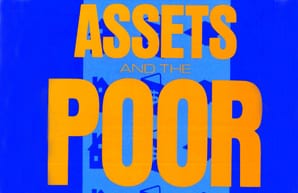Asset-building scholars, policymakers, and foundations gathered earlier this month in Washington, DC to celebrate the 21st anniversary of “Assets and the Poor: A New American Welfare Policy.” The Assets@21 symposium, hosted by the New America Foundation, provided an opportunity to take stock of the field’s progress since the publication of Michael Sherraden’s 1991 book and plot directions for the future. 
“While 1991 may have been a seminal moment for the asset-building field, 2012 is potentially a watershed moment for how we conceptualize and implement broader social policy reforms,” says Reid Cramer, Director of the New America Foundation’s asset building program. “It is a fitting time for thinking about the skills, education, assets, and policies that promote mobility, economic security, and resiliency in the 21st century.”
Notwithstanding modest gains made since the publication of Assets and the Poor in 1991, opportunities for saving and building assets continue to be limited for low-income Americans. During the last few years, the economic recession has revealed how household assets—especially in low-income households—continue to be vulnerable to shocks such as job loss.
A Revolutionary Idea
In Assets and the Poor, Sherraden, Benjamin Youngdahl Professor of Social Development at the Brown School and Director of the School’s Center for Social Development, proposed establishing individual savings accounts for the poor—also known as Individual Development Accounts (IDAs)—that would provide the same opportunities for publically-supported asset accumulation that are available to non-poor households.
IDAs have been adopted in federal legislation and in more than 40 states. Sherraden’s work on assets has influenced policy developments in the United Kingdom, Canada, China, Korea, and other countries.
Now Sherraden and CSD are focusing on testing Child Development Accounts (CDAs) in the United States. CDAs are savings accounts that begin as early as birth and allow parents and children to accumulate savings for postsecondary education, homeownership or business initiatives.
“The idea of CDAs is to provide an asset-building account to everyone beginning at birth,” says Sherraden. “Money would accumulate in these accounts and public funding would be progressive, with lower-income families receiving a higher contribution.”
Challenges Remain
Although there has been significant progress in the field over the last 21 years, challenges remain. The symposium included presentations by leading scholars in the asset-building field on some of these challenges, including the racial wealth gap, financial empowerment, savings interventions, and creating more inclusive policies:
- The racial wealth gap is continuing to increase. The racial wealth gap grew from $85,000 in 1984 to $236, 500 in 2009. Differences in income, homeownership, and inheritance appear to be driving the increase.
- Few households hold sufficient savings to tide them over in case of an economic shock, such as a job loss. If their regular income was interrupted, only half of households have enough liquid assets to cover 75%of one month’s income loss; only one-quarter have enough to cover 75% of three month’s income loss.
- Regarding homeownership, government policies have not yet achieved the right balance of promoting equal and fair access to credit while at the same time protecting consumers from abusive lending practices. Although innovations in mortgage lending and asset-based policies and programs led to a significant expansion of homeownership, the foreclosure crisis has reversed many of the gains achieved during the 1990s.
Forward Motion
At the same time, other research presented at the symposium pointed to heartening developments in the field:
- Research suggests that saving in a child’s name is associated with college success.
- Free tax coalitions and sites can serve as important link to asset-building programs and services for low-income Americans.
- Opportunities to create asset building opportunities at the state level should not be ignored.
- Saving programs based on insights from behavioral economics can be effective. Programs developed in the last decade aim to make saving easier—through automating, streamlining, and simplifying enrollment and contribution processes—and withdrawals harder—through allowing withdrawals at the teller but not an ATM, for example.
- The proposed ASPIRE Act would encourage inclusive savings with features such as automatic account opening, provision of an initial deposit, and matching contributions. Use of savings would be limited to development purposes such as post-secondary education, homeownership, or retirement.
The Next 20 Years
In the United States, a growing number of CDA programs are influenced by CSD’s research. San Francisco has rolled out “Kids 2 College,” with plans for CDAs for all kindergartners. A bipartisan group in Congress has introduced the America Saving for Personal Investment, Retirement and Education (ASPIRE) Act for the past several years, which would provide every newborn with a CDA with an initial $500 contribution.
In a large research initiative, CSD is leading the SEED for Oklahoma Kids (SEED OK) experiment, which tests the impact of giving every child a CDA at birth to be used for post-secondary education. This work is intended to inform a national CDA policy in the United States.
“Through SEED OK, we have randomly given 1,300 children an account and randomly selected 1,300 children as controls,” Sherraden says.
“This is a rigorous, scientific test of the CDA policy concept over time. We’re following the kids to see how they do in their early years and at school. Hopefully, someone will follow the children all the way through college.”
CSD is also studying savings accounts for youth in Colombia, Ghana, Kenya, and Nepal as part of the YouthSave initiative.